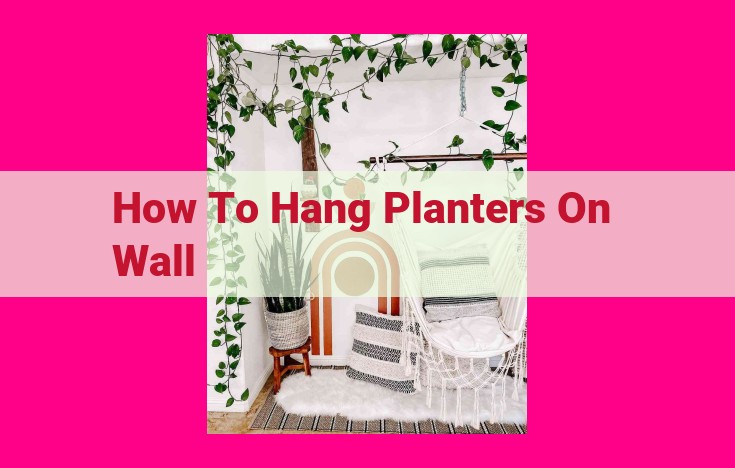Enliven Your Walls: A Comprehensive Guide To Hanging Planters On Various Surfaces

To stylishly enhance your walls, consider hanging planters. Explore planter materials like ceramic or metal. Select suitable mounting for your wall type, whether plaster, brick, or drywall. Ensure safety by considering drainage, soil type, and plant selection.
Materials for Vertical Planters: A Comprehensive Guide to Choosing the Right Planters
Embark on a journey into the realm of vertical gardening, where space constraints meet the beauty of nature. In this comprehensive guide, we’ll delve into the world of materials for vertical planters, exploring their durability, aesthetic appeal, and suitability for your unique needs.
Exploring the Options: A Diverse Range of Planters
From sturdy wooden planters that exude warmth and character to sleek metal planters that offer modern elegance, the choice of materials is as diverse as the gardens they adorn. For those yearning for a touch of nature, fabric planters provide a breathable, earthy option, while plastic planters offer lightweight convenience. Consider the style of your space, the plants you wish to grow, and the overall weight you need to support.
Durability: Ensuring Longevity in Vertical Spaces
In the vertical gardening realm, durability is paramount. Wood planters can withstand the elements with proper treatment, while metal planters offer unmatched strength and rust resistance. Fabric planters may require more frequent replacement, but they can provide excellent drainage. Plastic planters are lightweight and less prone to cracking, making them ideal for delicate plants. Choose materials that align with your intended plant choices and the exposure your planters will face.
Aesthetic Appeal: Elevating Your Vertical Oasis
Beyond functionality, the materials you choose should complement the aesthetic of your vertical garden. Wooden planters impart a rustic charm, while metal planters add a touch of industrial chic. The natural textures of fabric planters blend seamlessly with greenery, and the vibrant colors of plastic planters can inject a burst of fun. Consider the overall design of your space and select materials that harmonize with your décor and create a visually pleasing environment.
Mounting Options for Vertical Planters: A Comprehensive Guide
When it comes to vertical gardening, choosing the right mounting option is crucial. Different wall types have their own unique characteristics that determine the most suitable mounting method. Here’s a comprehensive guide to help you secure your vertical planters safely and effectively.
Plaster Walls
Plaster walls are porous and delicate, so** direct drilling into them should be avoided. Use adhesive hooks or special plaster anchors designed for heavy objects to mount your planters. These options provide a secure hold without damaging the wall.
Brick Walls
The sturdy nature of brick walls allows for more direct mounting methods. Use masonry screws or bolts to securely attach the planters to the mortar joints. Ensure that the screws or bolts are long enough to penetrate deep into the mortar, providing maximum support.
Concrete Walls
Concrete is an exceptionally durable surface that can withstand significant weight. Use concrete anchors or expansion bolts to mount your planters. These anchors expand within the concrete, creating a firm hold that can support heavy vertical gardens.
Drywall Walls
Drywall is a less sturdy material, so it’s important to avoid overburdening it. Use toggle bolts or butterfly anchors to distribute the weight evenly across the drywall. These anchors have wings that open behind the drywall, creating a more secure hold.
Additional Considerations
- Weight of the Planter: Choose a mounting method that can adequately support the weight of the planter, including both the soil and plants.
- Drainage: Ensure that there is proper drainage for the planters to prevent waterlogging and damage to the wall or plants.
- Plant Height: Consider the height of the plants when choosing a mounting method. Tall plants may require additional support to prevent them from toppling over.
- Safety: Always follow the manufacturer’s guidelines for mounting and ensure that the planters are securely attached to the wall to prevent accidents.
Techniques for Designing Safe and Thriving Vertical Planters
When embarking on the creation of a vertical planter, prioritizing safety is of paramount importance. Vertical planters, when filled with plants, soil, and water, can weigh significantly. Selecting the appropriate mounting system and ensuring it is securely installed is crucial to prevent accidents. Consider the weight capacity of the wall or surface where you intend to mount the planter and choose a system that can adequately support the load.
Equally important is ensuring proper drainage to prevent waterlogging, which can lead to root rot and other plant problems. Choose planters with built-in drainage holes or consider adding a layer of gravel or pebbles to the bottom of the planter to aid in draining excess water.
The soil you use in your vertical planter is also crucial for the health of your plants. Use a well-draining potting mix specifically formulated for container gardening. Avoid using garden soil, as it is often too heavy and can compact, restricting root growth and drainage.
Finally, carefully consider the plant selection for your vertical planter. Choose plants that are well-suited to vertical spaces and have浅浅的根系. Avoid plants with large or deep root systems that could damage the planter or wall. Additionally, consider the amount of sunlight your planter will receive and select plants that will thrive in those conditions.
By following these safety and design considerations, you can create a beautiful and thriving vertical planter that will add life and greenery to your indoor or outdoor space for years to come.